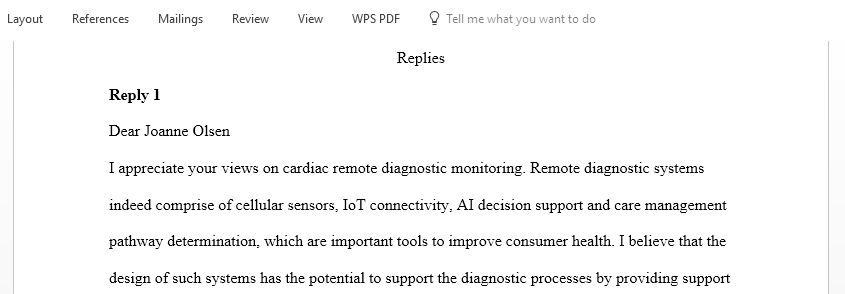Replies to cardiac remote diagnostic monitoring
Topic A-Clinical Utility. CARDIAC REMOTE DIAGNOSTIC MONITORING.
Remote diagnostics systems for chronic care management that include cellular sensors, internet of things connectivity, artificial intelligence decision support and care management pathway determination are aimed at improving consumer health. The Biotricity company, Biocentrix product is an example, in this space. The product provides personalized remote cardiac testing for real-time care management. The company received a FDA ruling of substantially equivalent July, 2020, moving the product into the remote patient competitive market space, which is expect to be USD $1.8 billion by 2026.
To competitively enter the market, the company needs to demonstrate to buyers and payers the clinical utility or added value of remote diagnostic testing of patients with a chronic cardiac diagnosis. The company needs to collect data to demonstrate the value of the product in streamlining workflow, improved patient outcomes and cost avoidance. To make the clinical utility case the company needs data on provider and payors cardiac care: recurring costs and one-time costs, key cardiac care quality performance metrics, labor costs, lost opportunity costs and reimbursement.
U.S. chronic diseases costs account for 75% of health care spending. Treating chronic conditions is estimated at USD $277 billion with a loss of USD $1 trillion in productivity. (Waters & Graf, 2018). Data on the US global costs of cardiac care is abundant in the literature. In addition, there is a torrent of research literature on remote monitoring and testing costs and outcomes from the Cochrane data base to pub Med.
Collecting the data, needed to model the clinical utility, is feasible, as the data is already collected. As Biotricity works with buyers and payors to model the business and clinical case data sources include: the National Cardiovascular Data Base registry (registry members collect the data); the European Society of Cardiology data base; CDC Heart Disease Map and Data Sources (National Center for Chronic Disease Prevention and Health Promotion publishes the data); the Medicare Physician Fee Schedule (CMS collects through billing codes providing large data sets with most insurance companies use the same billing codes) and CMS outcome measures for cardiac disease (collected by providers enrolled in Medicare & Medicaid reimbursement program).
Clinical utility is an important metric, in my view. It is important to encourage new approaches to designing improved treatment plans. Modeling clinical utility of new approaches, either positive or negative, is an important metric in evidence-based care.
References
Biotricity (2020). Biocentrix. Retrieved from https://www.biotricity.com/biocentrix/
Center for Disease Control (2019). Heart Disease. National Center for Chronic Disease Prevention and Health Promotion. Retrieved from https://www.cdc.gov/heartdisease/maps_data.htm (Links to an external site.)
Waters, H. & Graf, M. (2018, May). The Cost of Chronic Care in the U.S. Milken Institute. Retrieved from https://assets1b.milkeninstitute.org/assets/Publication/Viewpoint/PDF/Chronic-Disease-Executive-Summary-r2.pdf (Links to an external site.)
Great post. I love that you described a massive issue in personal and public health. I am wondering however, if you happen to see this reply, maybe you can provide the link to the FDA approval ruling for the device? I looked at the company’s website where they describe their innovative technology, BiofluxTM, as “FDA cleared” and not necessarily “FDA approved”: https://www.biotricity.com/bioflux/ (Links to an external site.). The biocentrix device you have linked says “Coming soon…”: https://www.biotricity.com/biocentrix/ (Links to an external site.). I am personally very curious since I’ve had a coworker pass away from a sudden cardiac event when nobody was around (a continuous ECG device may have very well saved his life). Also because Biotricity is a publicly traded company and a successful FDA approval could be a big investment opportunity….
Anyways, I see continuous ECG monitoring as a great option for continuous monitoring of a person’s free living heart health. However, I see one large issue with the device’s application, especially if it provides only limited clinical utility: it is still wearable. This may come as a surprise to many of you, but, wearable devices are inherently remiss in that many end users do not like to use them or do not use them. Take apple watch users for example. Many of them (myself included) use them for a period of time, become annoyed with charging them, and then eventually stop using them due to this minor inconvenience. Additionally, with ECG (odd but important note), people with chest hair would have issues installing/removing the device periodically to charge it. As such, I’d like to introduce an alternative many of you all are likely unfamiliar with: it is 100% possible (pending clinical validation) to measure heart rate and heart rate variability from video (A video camera that measures heart rate, blood pressure using only your face (Links to an external site.))! A camera can pick up minute changes in the redness of a persons face that occurs when their heart beats (cannot be detected by eye, but, a computer can amplify color change in a way that gives a quantitative metric of a person’s facial redness) and relate that to heart rate. This would be preferable in that it is not invasive, and therefore adds to the value of the diagnostic (since it is easier for the user to capture). This could be integrated into a laptop software that works in the background whenever a person’s laptop is turned on. Abnormalities in heart beat pattern (missed beat, weak beat, odd timing) can be related to cardiac disease. Overall, in addition to capturing the heart beat data, it is important to develop a metric that can be used for diagnosis. For example, BPM is typically not enough to determine if a person is at risk of heart attack or not. Heart rate variability has more value in that regard but is still not a perfect predictor. Anyways, great post!
Answer preview for Replies to cardiac remote diagnostic monitoring
Access the full answer containing 314 words by clicking the below purchase button

